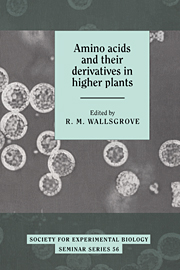Book contents
- Frontmatter
- Contents
- List of contributors
- Preface
- Glutamine synthetase in higher plants: molecular biology meets plant physiology
- Interactions of nitrogen and carbon metabolism: implications of PEP carboxylase and isocitrate dehydrogenase
- The genetics of aspartate derived amino acids in higher plants
- Oxidation of 1-aminocyclopropane-1-carboxylic acid (ACC) in the generation of ethylene by plants
- Regulation of carbon flow through the branched chain amino acid biosynthetic pathway
- Amino acid metabolism and protein deposition in the endosperm of wheat: synthesis of proline via ornithine
- The glycine decarboxylase complex in higher plant mitochondria: structure, function and biogenesis
- Glycine and serine synthesis in non-photosynthetic tissues
- Biogenesis of N-heterocydic amino acids by plants: mechanisms of biological significance
- Toxicity of non-protein amino acids from plants
- Processes involved in glutathione metabolism
- Betaines in higher plants – biosynthesis and role in stress metabolism
- Metabolism and function of polyamines during osmotically induced senescence in oat leaves and protoplasts
- Biosynthesis of cyanogenic glucosides. Elucidation of the pathway and characterization of the cytochromes P-450 involved
- The biosynthesis of glucosinolates in Brassicas
- Biochemical genetics of aliphatic glucosinolates in Brassica and Arabidopsis
- Index
Processes involved in glutathione metabolism
Published online by Cambridge University Press: 09 April 2010
- Frontmatter
- Contents
- List of contributors
- Preface
- Glutamine synthetase in higher plants: molecular biology meets plant physiology
- Interactions of nitrogen and carbon metabolism: implications of PEP carboxylase and isocitrate dehydrogenase
- The genetics of aspartate derived amino acids in higher plants
- Oxidation of 1-aminocyclopropane-1-carboxylic acid (ACC) in the generation of ethylene by plants
- Regulation of carbon flow through the branched chain amino acid biosynthetic pathway
- Amino acid metabolism and protein deposition in the endosperm of wheat: synthesis of proline via ornithine
- The glycine decarboxylase complex in higher plant mitochondria: structure, function and biogenesis
- Glycine and serine synthesis in non-photosynthetic tissues
- Biogenesis of N-heterocydic amino acids by plants: mechanisms of biological significance
- Toxicity of non-protein amino acids from plants
- Processes involved in glutathione metabolism
- Betaines in higher plants – biosynthesis and role in stress metabolism
- Metabolism and function of polyamines during osmotically induced senescence in oat leaves and protoplasts
- Biosynthesis of cyanogenic glucosides. Elucidation of the pathway and characterization of the cytochromes P-450 involved
- The biosynthesis of glucosinolates in Brassicas
- Biochemical genetics of aliphatic glucosinolates in Brassica and Arabidopsis
- Index
Summary
Introduction
A major part of our present knowledge on the processes involved in glutathione metabolism originates from research performed by animal and human biochemists and physiologists up to the late 1970s (Meister, 1981; Meister & Anderson, 1983). Until that time interest of plant biochemists and physiologists in research on glutathione was rather low. Apparently, it was assumed that experiments on glutathione metabolism performed with animal tissues had provided answers that are also valid for plants. This situation changed entirely about a decade ago, when it became obvious that glutathione is an important factor in stress physiology of plants (Smith, Polle & Rennenberg, 1990; Rennenberg & Brunold, 1994). Glutathione was found to be an antioxidant, both as a constituent of the chemical defence system and as a substrate of the enzymatic defense system in the cytoplasm and the chloroplasts of the cells (Polle & Rennenberg, 1993, 1994). Glutathione was found to counteract heat, cold and drought stress (Smith et al, 1990). Glutathione was identified as a substrate for the conjugation of xenobiotics (Rennenberg & Lamoureux, 1990) and for the synthesis of phytochelatins, i.e. poly(γ-glutamylcysteinyl)-glycines involved in metal homeostasis and metal detoxification (Rennenberg & Brunold, 1994). Glutathione was found to be involved in signal transduction in plant-pathogen interactions (Rennenberg & Brunold, 1994). Glutathione was found to be a storage form of reduced sulphur, compensating stress from excess sulphur in plants (Rennenberg, 1984; De Kok, 1990).
- Type
- Chapter
- Information
- Amino Acids and their Derivatives in Higher Plants , pp. 155 - 172Publisher: Cambridge University PressPrint publication year: 1995
- 26
- Cited by



